Exploring Environmental Effects on Dental Changes: Insights from a Scoping Review and Preliminary Experimental Study
Abstract
1. Introduction
2. Materials and Methods
2.1. Part-1
2.2. Part-2
3. Results
4. Discussion
5. Conclusions
Author Contributions
Funding
Institutional Review Board Statement
Informed Consent Statement
Data Availability Statement
Acknowledgments
Conflicts of Interest
References
- Adams, B.J. Establishing personal identification based on specific patterns of missing, filled, and unrestored teeth. J. Forensic Sci. 2003, 48, 487–496. [Google Scholar] [CrossRef] [PubMed]
- Weedn, V.W. Postmortem identifications of remains. Clin. Lab. Med. 1998, 18, 115–137. [Google Scholar] [CrossRef]
- Bush, M.A.; Bush, P.J.; Miller, R.G. Detection and classification of composite resins in incinerated teeth for forensic purposes. J. Forensic Sci. 2006, 51, 636–642. [Google Scholar] [CrossRef] [PubMed]
- Muller, M.; Berytrand, M.F.; Quatrehomme, G.; Bolla, M.; Rocca, J.P. Macroscopic and microscopic aspects of incinerated teeth. J. Forensic Odontostomatol. 1998, 16, 1–7. [Google Scholar] [PubMed]
- Kadashett, V.; Shivakumar, K.; Baad, R.; Vibhute, N.; Belgaumi, U.; Bommanavar, S.; Kamate, W. Effect of concentrated acids on teeth: A forensic approach; An In-vitro study. J. Datta Meghe Inst. Med. Sci. Univ. 2021, 16, 283–289. [Google Scholar] [CrossRef]
- Biancalana, R.C.; Vicente, S.A.; Alves da Silva, R.H.; Pires-de-Souza, F.C. Color Stability of Dental Restorative Materials Submitted to Heat Sources, for Forensic Purposes. J. Forensic Sci. 2017, 62, 355–360. [Google Scholar] [CrossRef]
- de Freitas Vincenti, S.A.; Biancalana, R.C.; Alves da Silva, R.H.; De Carvalho Panzeri Pires-de-Souza, F. Colour stability of dental restorative materials submitted to conditions of burial and drowning, for forensic purposes. J. Forensic Odontostomatol. 2018, 36, 20–30. [Google Scholar]
- Biancalana, R.C.; Freitas Vincenti, S.A.; Alves da Silva, R.H.; Carvalho Panzeri Pires-de-Souza, F. Color stability of dental restorative materials submitted to cold temperatures for forensic purposes. J. Forensic Leg. Med. 2017, 51, 63–68. [Google Scholar] [CrossRef]
- Ugrappa, S.; Jain, A. An Emergence of Dental Tissues in the Forensic Medicine for the Postmortem Interval Estimation: A Scoping Review. J. Forensic Sci. Med. 2021, 7, 54–60. [Google Scholar] [CrossRef]
- Kaliszan, M.; Hauser, R.; Kernbach-Wighton, G. Estimation of the time of death based on the assessment of post mortem processes with emphasis on body cooling. Leg. Med. 2009, 11, 111–117. [Google Scholar] [CrossRef]
- Merriam, T.; Kaufmann, R.; Ebert, L.; Figi, R.; Erni, R.; Pauer, R.; Sieberth, T. Differentiation of dental restorative materials combining energy-dispersive X-ray fluorescence spectroscopy and post-mortem, C.T. Forensic Sci. Med. Pathol. 2018, 14, 163–173. [Google Scholar] [CrossRef] [PubMed]
- Sampaio-Silva, F.; Magalhães, T.; Carvalho, F.; Dinis-Oliveira, R.J.; Silvestre, R. Profiling of RNA degradation for estimation of post mortem [corrected] interval. PLoS ONE 2013, 8, e56507. [Google Scholar] [CrossRef] [PubMed]
- de Almeida Salema, C.F.B.; de Barros Silva, P.G.; da Costa Oliveira, P.M.; Lima, J.P.M.; da Silva, R.H.A.; Nobre, T.F.G.; Bezerra, T.P. Forensic study of mechanical properties of dental restoration after burial in mangrove environment. Forensic Sci. Int. 2020, 308, 110166. [Google Scholar] [CrossRef] [PubMed]
- Whittaker, D.K.; MacDonald, D.G. A Colour Atlas of Forensic Dentistry; Wolfe Medical Publications: London, UK, 1989. [Google Scholar]
- Chu, S.J.; Paravina, R.D.; Sailer, I.; Mieleszko, A.J. Color in Dentistry: A Clinical Guide to Predictable Esthetics; Quintessence Publishing: Berlin, Germany, 2017. [Google Scholar]
- Ubelaker, D.H. The forensic evaluation of burned skeletal remains: A synthesis. Forensic Sci. Int. 2009, 183, 1–5. [Google Scholar] [CrossRef]
- Delattre, V.F. Burned beyond recognition: Systematic approach to the dental identification of charred human remains. J. Forensic Sci. 2000, 45, 589–596. [Google Scholar] [CrossRef]
- Kolude, B.; Adeyemi, B.F.; Taiwo, J.O.; Sigbeku, O.F.; Eze, U.O. The role of forensic dentist following mass disaster. Ann. Ib. Postgrad. Med. 2010, 8, 111–117. [Google Scholar] [CrossRef][Green Version]
- Seethapathy, T.; Shylaja, S.; Sekhar, M.S.M.; Manthapuri, S.; Ramanand, O.V.; Reddy, S.K.; Paul, J.B.; Funato, A.; Kubo, K.; Maeda, H.; et al. Effect of acids on teeth and restorative materials: An aid in forensic odontology. J. Hard Tissue Biol. 2019, 28, 21–30. [Google Scholar] [CrossRef]
- Cleary, M.; Visentin, D.C.; West, S.; Say, R.; McLean, L.; Kornhaber, R. Acid burn attacks: Looking beneath the surface. J. Adv. Nurs. 2018, 74, 1737–1739. [Google Scholar] [CrossRef]
- Biancalana, R.C.; Vincenti, S.A.d.F.; da Silva, R.H.A.; Pires-de-Souza, F.C.P. Analysis of the surface roughness and microhardness of dental restorative materials exposed to heat sources and cold temperatures for human identification purposes. Egypt. J. Forensic Sci. 2019, 9, 8. [Google Scholar] [CrossRef]
- Zimmer, S.; Kirchner, G.; Bizhang, M.; Benedix, M. Influence of various acidic beverages on tooth erosion. Evaluation by a New Method. PLoS ONE 2015, 10, e0129462. [Google Scholar] [CrossRef]
- Wang, C.; Li, Y.; Wang, X.; Zhang, L.; Tiantang; Fu, B. The Enamel Microstructures of Bovine Mandibular Incisors. Anat. Rec. 2012, 295, 1698–1706. [Google Scholar] [CrossRef] [PubMed]
- Acharya, A.B. Reflections on setting up forensic odontology department, its activities, and faculty. J. Forensic Dent. Sci. 2019, 11, 167–168. [Google Scholar] [CrossRef] [PubMed]
- Hau, T.C.; Hamzah, N.H.; Lian, H.H.; Hamzah, S. Decomposition process and post mortem changes. Sains Malays. 2014, 43, 1873–1882. [Google Scholar]
- Janaway, R.C.; Wilson, A.S.; Díaz, G.C.; Guillen, S. Taphonomic Changes to the Buried Body in Arid Environments: An Experimental Case Study in Peru. In Criminal and Environmental Soil Forensics; Ritz, K., Dawson, L., Miller, D., Eds.; Springer: Dordrecht, The Netherlands, 2009; pp. 341–356. [Google Scholar] [CrossRef]
- Franco, A.; de Oliveira, M.N.; Gomes-Lima, L.K.; Pereira-de-Oliveira, V.H.F.; Franco, R.; Blumenberg, C.; Silva, R.F.; da Silva, R.H.A.; Makeeva, I.; Santos-Filho, P.C.F.; et al. Case-specific characteristics of pink teeth in dental autopsies—A systematic review. J. Forensic Leg. Med. 2019, 68, 101869. [Google Scholar] [CrossRef]
- Cañedo-Argüelles, M.; Kefford, B.; Schäfer, R. Salt in freshwaters: Causes, effects and prospects—Introduction to the theme issue. Philos. Trans. R. Soc. Lond. B Biol. Sci. 2018, 374, 20180002. [Google Scholar] [CrossRef]
- Manoilescu, I.; Ion, A.; Ioan, B.G. Post-Mortem Changes in Teeth- Forensic Issues. Int. J. Med. Dent. 2015, 5, 249–252. [Google Scholar]
- Oliveira Fernandes, A.P.; Jacometti, B.V.; de Carvalho Panzeri Pires de Souza, F.; Alves da Silva, R.H. Radiographic changes in endodontically treated teeth submitted to drowning and burial simulations: Is it a useful tool in forensic investigation? J. Forensic Odontostomatol. 2021, 1, 9–15. [Google Scholar]
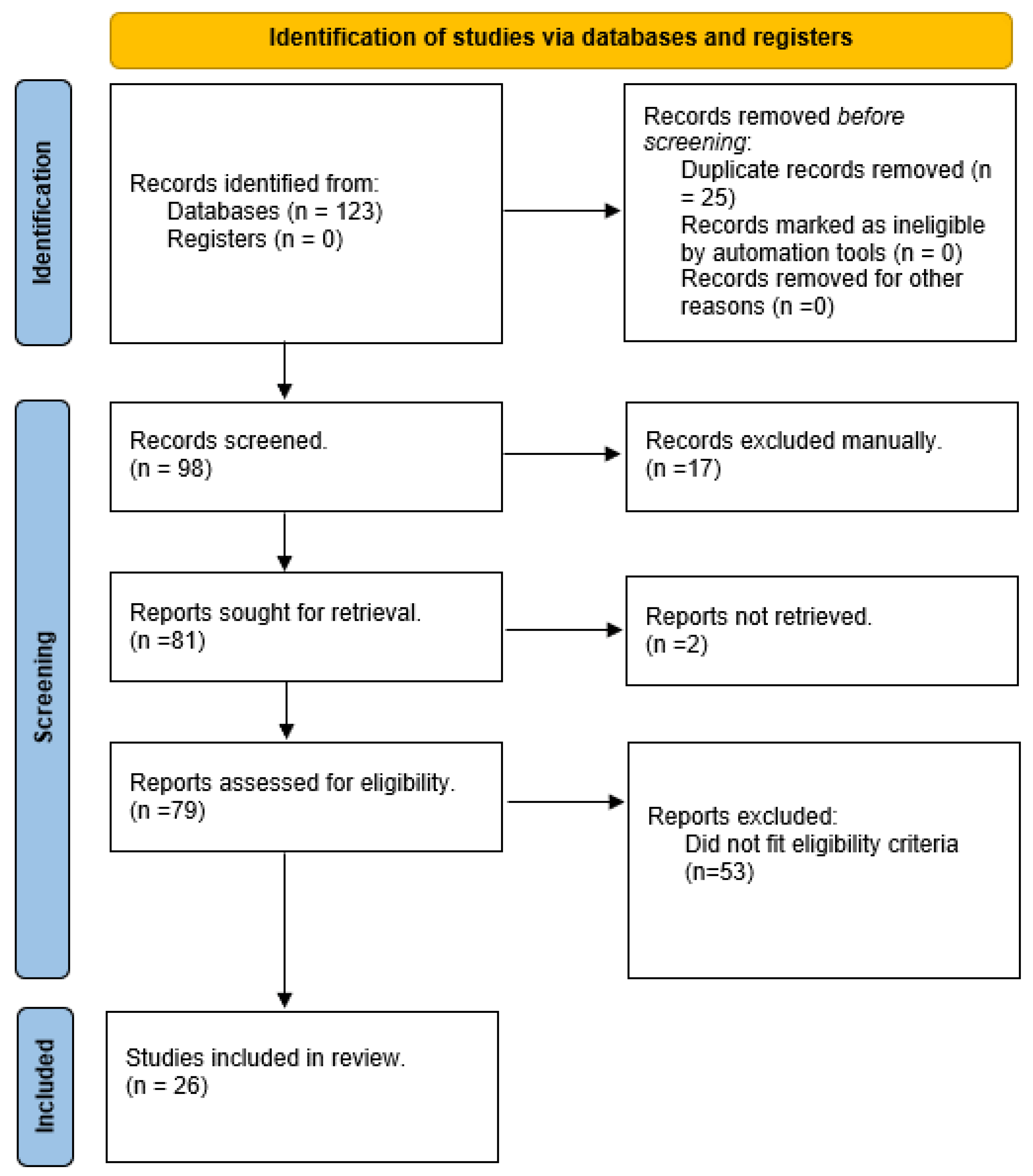
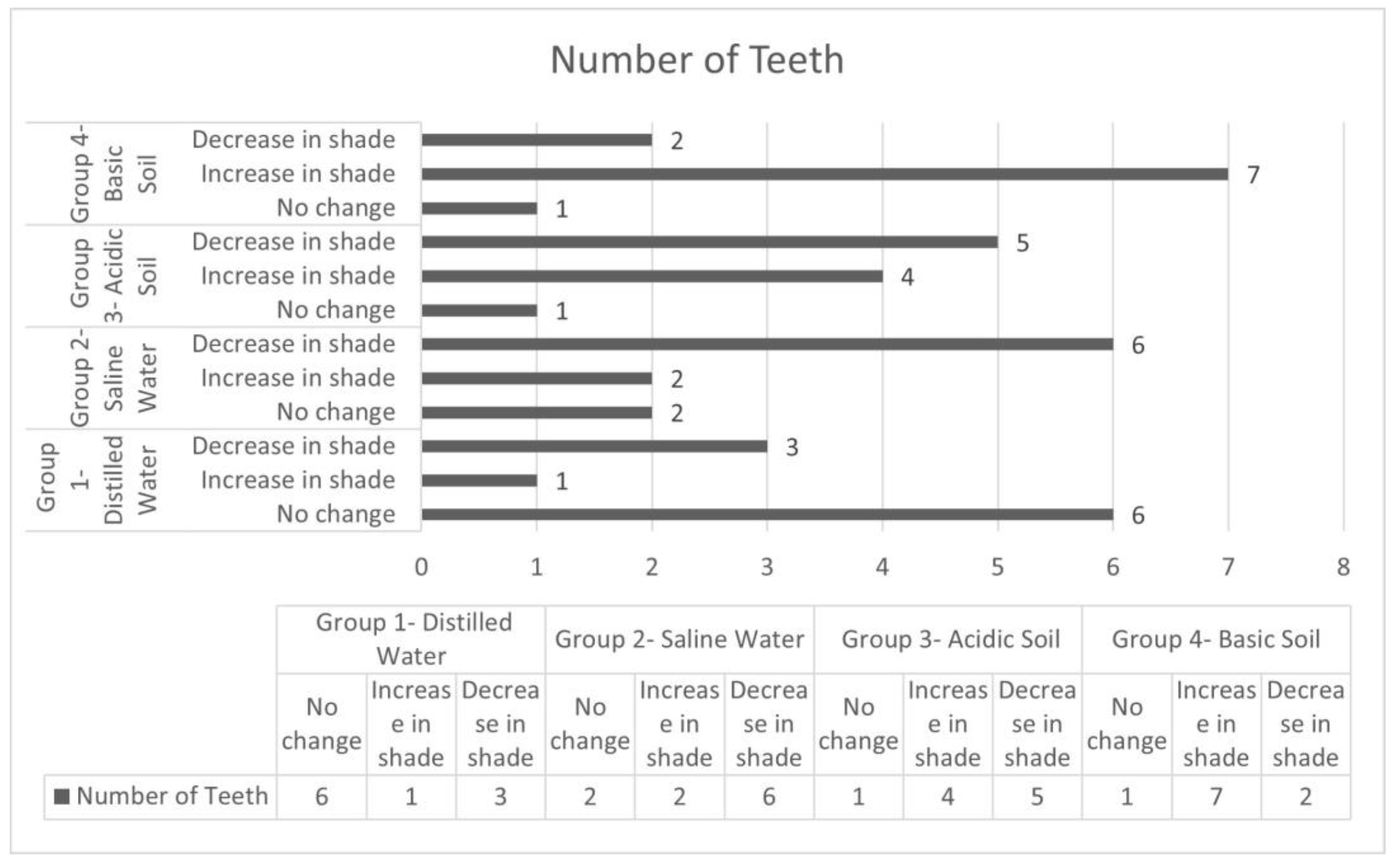
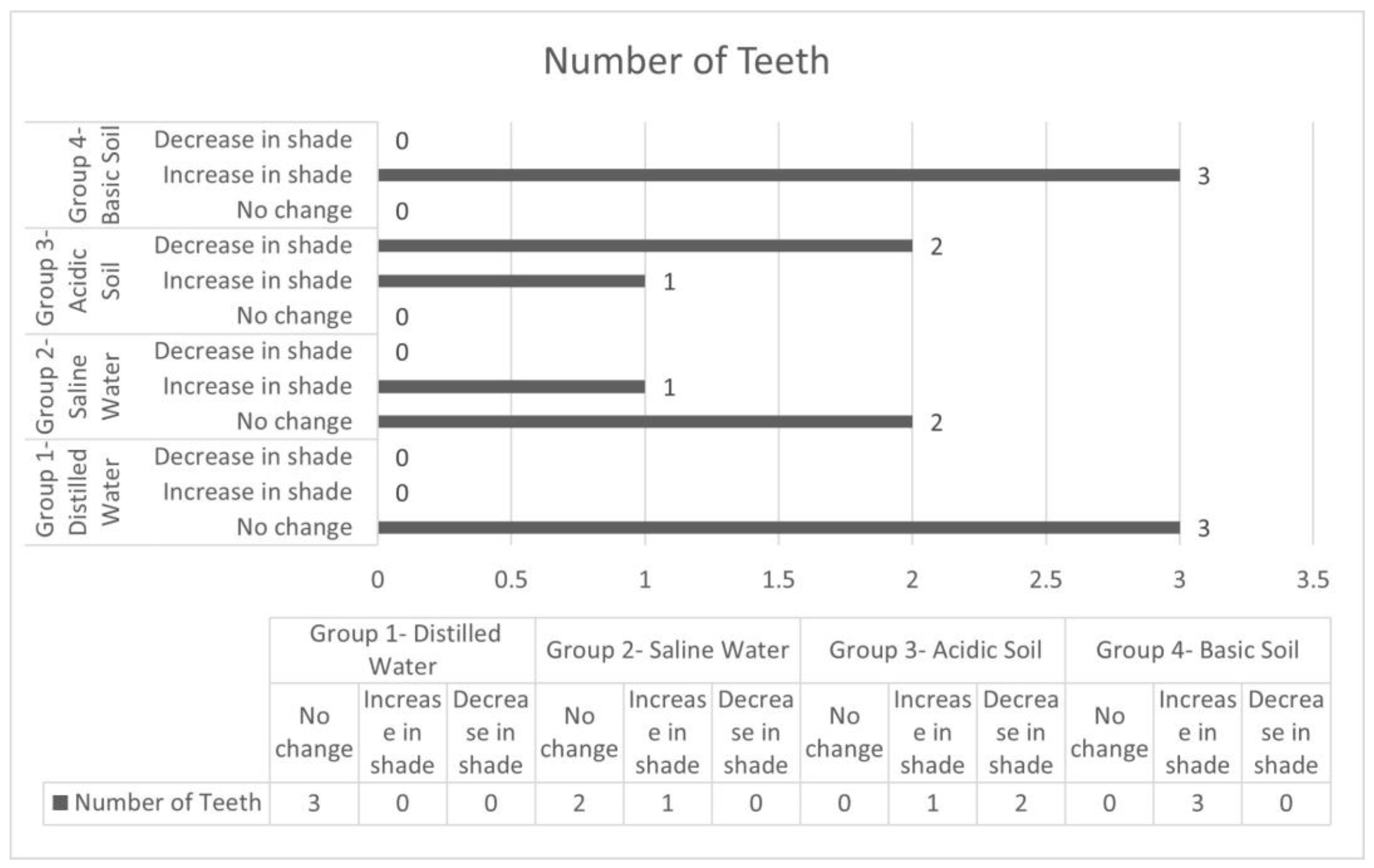
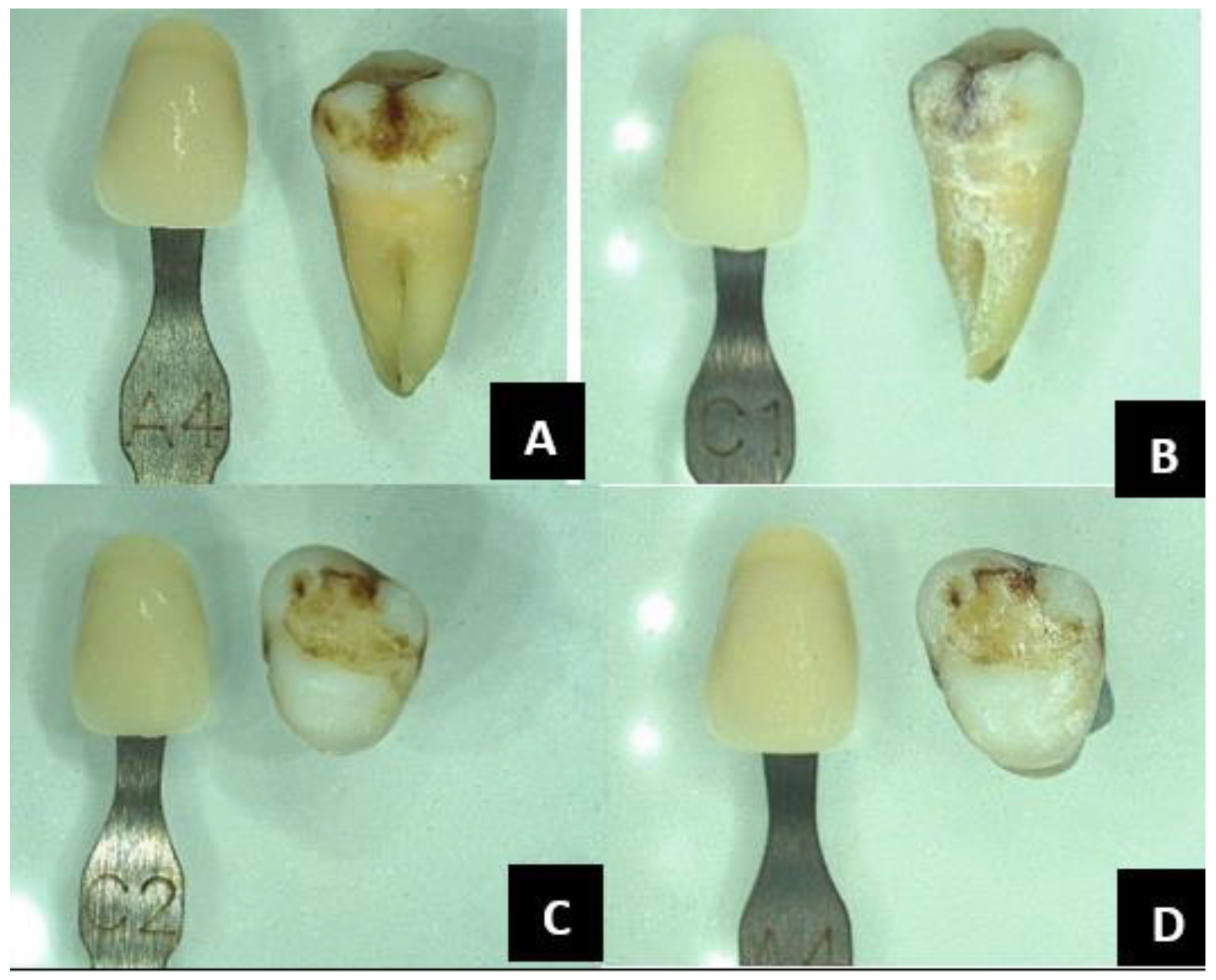
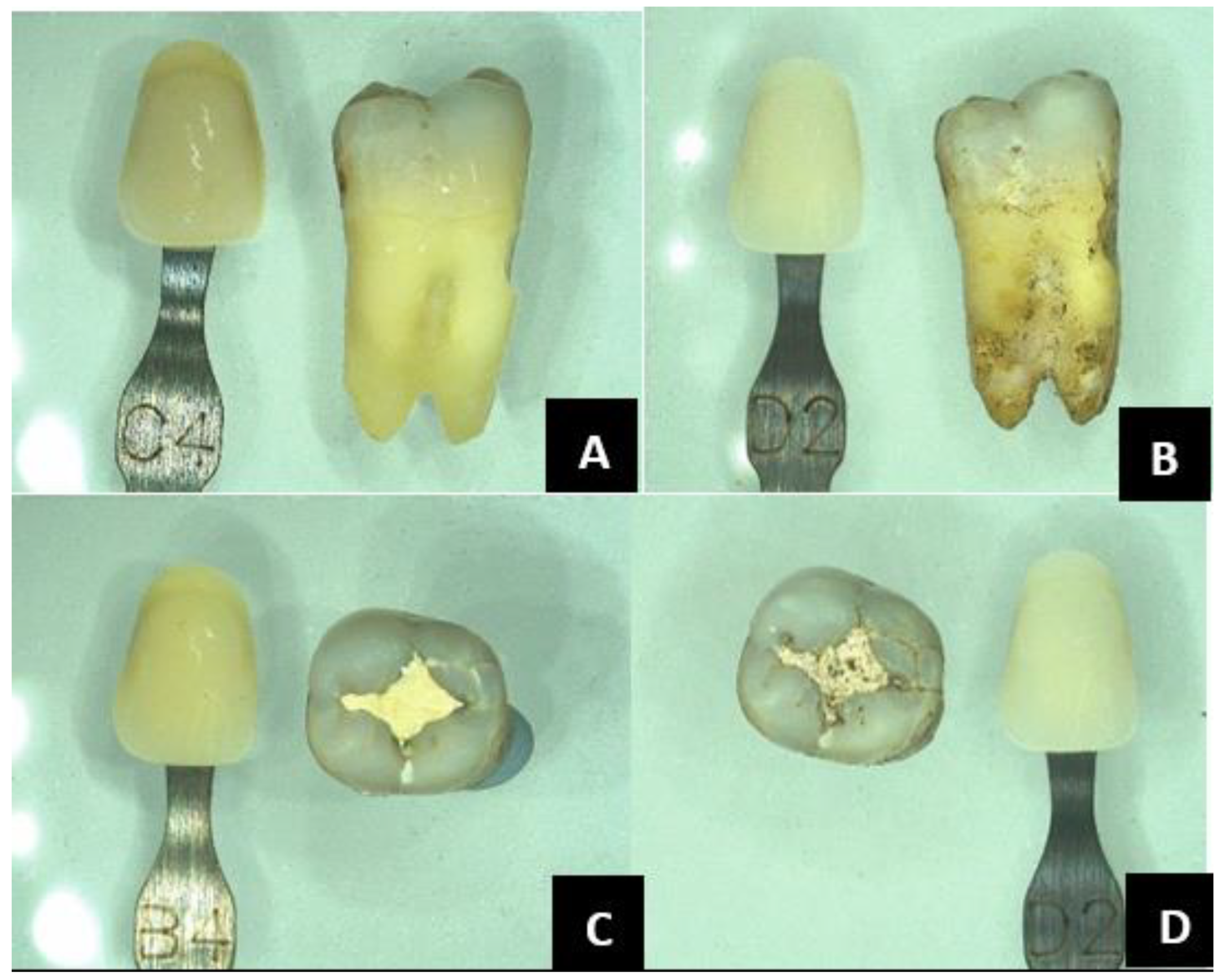
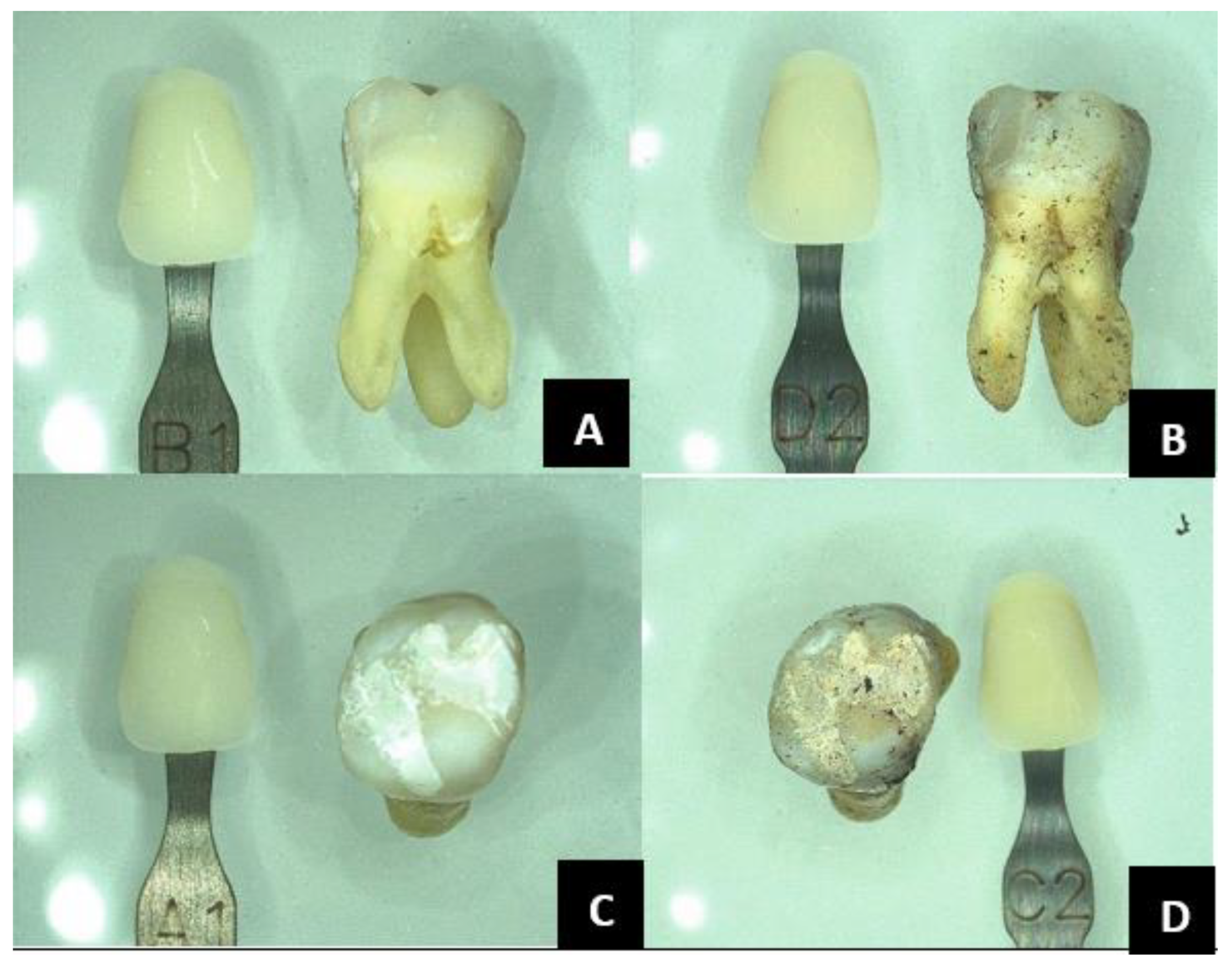
| Group | Keywords | Search String |
|---|---|---|
| 1-Dental | Teeth Tooth Dentition Dental | Teeth OR Dentition OR Tooth OR Dental |
| 2-Environment | Water Saline Drown * Fire Burn * Soil Burial Acid * | Water OR Drown * OR Saline OR Fire OR Burn * OR Soil OR Buri * OR Erosion OR Acid * OR environment * |
| 3-Use in forensic odontology | Change * Forensic Odontology | Change * AND Forensic AND Odontology |
| Ten TEETH of G1 | CONDITION Sound/Restored/Decayed | Ten TEETH of G3 | CONDITION Sound/Restored/Decayed |
|---|---|---|---|
| Mandibular 1st Premolar | Sound | Mandibular 2nd Premolar | Sound |
| Maxillary 2nd Premolar | Sound | Maxillary 1st Premolar | Sound |
| Maxillary 2nd Premolar | Sound | Maxillary 2nd Premolar | Sound |
| Maxillary 2nd molar | Restored (Class II Disto-occlusal); decayed | Mandibular 1st Molar | Restored (Class II Mesio-occlusal); decayed |
| Maxillary 2nd Premolar | Restored (Class II Disto-occlusal); decayed | Maxillary 2nd Molar | Restored (Class II Disto-occlusal); decayed |
| Mandibular 1st Molar | Restored (Class I Occlusal amalgam); | Mandibular 2nd Molar | Restored (Class I Occlusal amalgam) |
| Mandibular 2nd Molar | Restored (Class I Occlusal amalgam); Class II mesially decayed | Mandibular 1st Molar | Restored (Class I Occlusal amalgam) |
| Mandibular 2nd Premolar | Restored (Class V buccal composite) | Maxillary 3rd Molar | Restored (Class I composite) |
| Mandibular 2nd Molar | Restored (Class II Disto-occlusal composite) | Maxillary 2nd Molar | Restored (Class I Occlusal composite) |
| Mandibular 2nd Molar | Restored (Class I Bucco-occlusal GIC) | Mandibular 1st Molar | Restored (Class II Disto-occlusal GIC) |
| Ten TEETH of G3 | Ten TEETH of G4 | ||
| Mandibular 1st Premolar | Sound | Maxillary 1st Premolar | Sound |
| Mandibular 1st Premolar | Sound | Maxillary Central Incisor | Sound |
| Maxillary Central incisor | Sound | Mandibular 1st Molar | Sound |
| Maxillary 2nd Molar | Restored (Class II Disto-occlusal); decayed | Mandibular 2nd Molar | Restored (Class II Disto-occlusal; decayed |
| Mandibular 2nd Molar | Restored (Class II Disto-occlusal); decayed | Maxillary Canine | Restored (Class III Mesial); decayed |
| Maxillary 2nd Premolar | Restored (Class II Mesio-Occluso-Palatal amalgam) | Maxillary 1st Molar | Restored (Class II Disto-occlusal Amalgam); Class II Distally decayed |
| Maxillary 2nd Molar | Restored (Class I amalgam) | Maxillary 3rd Molar | Restored (Class I occlusal amalgam) |
| Maxillary 1st Molar | Restored (Class I composite) | Maxillary 1st Molar | Restored (Class I occlusal composite) |
| Maxillary 2nd Premolar | Restored (Class I composite) | Mandibular 2nd Premolar | Restored (Class V buccal composite) |
| Mandibular 2nd Molar | Restored (Class I GIC) | Maxillary Central Incisor | Restored (Class V buccal GIC) |
| Tab | B1 | A1 | B2 | D2 | A2 | C1 | C2 | D4 | A3 | D3 | B3 | A3.5 | B4 | C3 | A4 | C4 |
|---|---|---|---|---|---|---|---|---|---|---|---|---|---|---|---|---|
| SGU | 1 | 2 | 3 | 4 | 5 | 6 | 7 | 8 | 9 | 10 | 11 | 12 | 13 | 14 | 15 | 16 |
| Title, Year, and Country of Publishing | Environment | Tooth Classification (Human/Animal). Further Information If Available | Tooth State (Restored—R; Unrestored—U). Further Information If Available | Changes Observed (Yes—Y/ No—N) | Type of Research (Macroscopic/ Microscopic/ Both) |
|---|---|---|---|---|---|
| 1. Effect of various temperatures on restored and unrestored teeth: a forensic study, 2014, India | High temperature (heat) | Human | R/U | Y | Both |
| 2. Analysis of the surface roughness and microhardness of dental restorative materials exposed to heat sources and cold temperatures for human identification purposes, 2019, Brazil | High temperature and low temperature (heat and cold) | Animal—bovine | R (silver amalgam, composite resin, and glass ionomer cement) | N | Both |
| 3. Colour stability of dental restorative materials submitted to cold temperatures for forensic purposes, 2017, Brazil | Low temperature (cold) | Animal—bovine | R (Composite, GIC) | Y | Macroscopic |
| 4. Forensic study of mechanical properties of dental restoration after burial in mangrove environment, 2020, Brazil | Burial | Animal—bovine | R (silver amalgam, composite resin and glass ionomer cement) | Y | Macroscopic |
| 5. Colour stability of dental restorative materials submitted to conditions of burial and drowning for forensic purposes, 2018, Brazil | Burial, drowning | Animal—bovine | R (Composite and GIC) | Y | Macroscopic |
| 6. Evaluation of macroscopic changes and the efficiency of DNA profiling from burnt teeth, 2016, United States | High temperature (heat) | Human | U | Y | Both |
| 7. Morphologic and radiographic effects of acids on the teeth: an in vitro forensic study, 2020, India | Acid | Human | U | Y | Both |
| 8. A method for estimating time since death through analysis of substances deposited on the surface of dental enamel in a body immersed in freshwater, 2022, Japan | Drowning | Human | U | Y | Microscopic |
| 9. Effect of concentrated acids on teeth: a forensic approach, an in vitro study, 2021, India | Acid | Human | U | Y | Macroscopic |
| 10. Analysis of hard dental tissues and bone exposed to concentrated acids: an observational study, 2018, India | Acid | Human | U | Y | Macroscopic |
| 11. Effect of high temperature on crowns as post-endodontic restoration in forensic analysis: an in vitro study, 2017, India | High temperature (heat) | Human | R (All-ceramic crown, metal–ceramic crown) | Y | Macroscopic |
| 12. Behaviour in vitro of the dentin–enamel junction in human premolars submitted to high temperatures: prediction of the maximum temperature based on logistic regression analysis, 2016, Colombia | High temperature (heat) | Human | U | Y | Microscopic |
| 13. Observations on dental prostheses and restorations subjected to high temperatures: experimental studies to aid identification processes, 2002, Italy | High temperature (heat) | Human | R (prosthesis)/U | Y | Both |
| 14. In vitro behaviour of the dental tissues and some dental materials subjected to high temperatures with forensic purposes, 2008, Colombia | High temperature (heat) | Human | U | N | Both |
| 15. Macroscopic and microscopic aspects of incinerated teeth, 1998, France | High temperature (heat) | Human | U | Y | Both |
| 16. Radiographic changes in endodontically treated teeth submitted to drowning and burial simulations: Is it a useful tool in forensic investigation?, 2021, Brazil | Burial, drowning | Animal—bovine | R (endodontically treated teeth) | Y | Microscopic |
| Forensic identification of endodontically treated teeth after heat-induced alterations: an in vitro study, 2020, India | High temperature (heat) | Human | R (endodontically treated teeth) | Y | Both |
| Effect of concentrated and dilute nitric acid on tooth morphology—a forensic study, 2022, India | Acid | Human | U | Y | Macroscopic |
| Forensic study of mechanical properties of dental fillings after immersion in marine environment, 2020, Brazil | Drowning | Animal—bovine | R (silver amalgam, resin composite, or glass ionomer cement) | Y | Macroscopic |
| Influence of heating regimes on dimensional and colorimetric changes in teeth, 2015, United Kingdom | High temperature (heat) | Human | U | Y | Macroscopic |
| Volume analysis of heat-induced cracks in human molars: a preliminary study, 2014, Austria | High temperature (heat) | Human | U | Y | Macroscopic |
| X-ray scattering evaluation of ultrastructural changes in human dental tissues with thermal treatment, 2014, United Kingdom | High temperature (heat) | Human | U | Y | Microscopic |
| Effect of acids on teeth and restorative materials: an aid in forensic odontology, 2019, India | Acid | Human | R (amalgam, composite, GIC/U) | Y | Macroscopic |
| Assessment of morphological changes and DNA quantification: an in vitro study on acid-immersed teeth, 2013, India | Acid | Human | U | Y | Both |
| DNA analysis of dental pulp to link incinerated remains of homicide victim to crime scene, 1995, Canada | High temperature (heat) | Human | R/U | Y | Microscopic |
| Scanning electron microscopy of incinerated teeth, 1987, Australia | High temperature (heat) | Human | U | Y | Macroscopic |
| Environment | Tooth Number | Shade Changes in Teeth | Summary of Tooth Shade Changes | Shade Changes in Tooth-Coloured Restoration, If Any | Summary of Restoration Shade Changes |
|---|---|---|---|---|---|
| Group 1—Distilled Water | 1 | 0 | A1-A1 | n/a | n/a |
| 2 | −1 | A4-C3 | n/a | n/a | |
| 3 | 0 | C4-C4 | 0 | D2-D2 | |
| 4 | 0 | A4-A4 | 0 | A1-A1 | |
| 5 | +1 | A1-B1 | n/a | n/a | |
| 6 | 0 | A1-A1 | n/a | n/a | |
| 7 * | −4 | C3-D3 | n/a | n/a | |
| 8 * | 0 | C3-C3 | n/a | n/a | |
| 9 | −3 | C2-D2 | n/a | n/a | |
| 10 | 0 | B1-B1 | 0 | B1 | |
| Group 2—Saline Water | 1 | −5 | C1-B1 | n/a | n/a |
| 2 | 0 | D3-D3 | n/a | n/a | |
| 3 | −3 | C2-D2 | n/a | n/a | |
| 4 | −3 | C2-D2 | n/a | n/a | |
| 5 * | +2 | D2-C1 | n/a | n/a | |
| 6 | −5 | D3-A2 | 0 | A1-A1 | |
| 7 * | 0 | A1-A1 | n/a | n/a | |
| 8 | −4 | C1-A1 | n/a | n/a | |
| 9 | −9 | A4-C1 | +8 | C2-A4 | |
| 10 | +1 | A4-C4 | 0 | A1-A1 | |
| Group 3—Acidic Soil | 1 | +2 | A1-D2 | n/a | n/a |
| 2 | +4 | A1-C1 | n/a | n/a | |
| 3 | +2 | A1-D2 | n/a | n/a | |
| 4 | +12 | A1-C3 | n/a | n/a | |
| 5 | −3 | C2-D2 | −3 | C2-D2 | |
| 6 | −2 | C2-A2 | n/a | n/a | |
| 7 * | −6 | C4-D3 | n/a | n/a | |
| 8 * | 0 | D4-D4 | n/a | n/a | |
| 9 | −12 | C4-D2 | −9 | B4-D2 | |
| 10 | −3 | D2-B1 | +2 | A2-C2 | |
| Group 4—Alkaline Soil | 1 | −1 | A1-B1 | n/a | n/a |
| 2 | +15 | B1-C4 | +13 | B2-C4 | |
| 3 | +2 | A2-C2 | +2 | A2-C2 | |
| 4 | +1 | A2-C1 | n/a | n/a | |
| 5 | +5 | A2-D3 | n/a | n/a | |
| 6 | +3 | B1-D2 | +5 | A1-C2 | |
| 7 | −1 | A2-D2 | n/a | n/a | |
| 8 * | +6 | D2-D3 | n/a | n/a | |
| 9 | +5 | A3-C3 | n/a | n/a | |
| 10 * | 0 | C4-C4 | n/a | n/a |
Disclaimer/Publisher’s Note: The statements, opinions and data contained in all publications are solely those of the individual author(s) and contributor(s) and not of MDPI and/or the editor(s). MDPI and/or the editor(s) disclaim responsibility for any injury to people or property resulting from any ideas, methods, instructions or products referred to in the content. |
© 2025 by the authors. Licensee MDPI, Basel, Switzerland. This article is an open access article distributed under the terms and conditions of the Creative Commons Attribution (CC BY) license (https://creativecommons.org/licenses/by/4.0/).
Share and Cite
Gopakumar, P.K.; Pandey, H.; Mânica, S. Exploring Environmental Effects on Dental Changes: Insights from a Scoping Review and Preliminary Experimental Study. Forensic Sci. 2025, 5, 12. https://doi.org/10.3390/forensicsci5010012
Gopakumar PK, Pandey H, Mânica S. Exploring Environmental Effects on Dental Changes: Insights from a Scoping Review and Preliminary Experimental Study. Forensic Sciences. 2025; 5(1):12. https://doi.org/10.3390/forensicsci5010012
Chicago/Turabian StyleGopakumar, Parvathy Kollatt, Hemlata Pandey, and Scheila Mânica. 2025. "Exploring Environmental Effects on Dental Changes: Insights from a Scoping Review and Preliminary Experimental Study" Forensic Sciences 5, no. 1: 12. https://doi.org/10.3390/forensicsci5010012
APA StyleGopakumar, P. K., Pandey, H., & Mânica, S. (2025). Exploring Environmental Effects on Dental Changes: Insights from a Scoping Review and Preliminary Experimental Study. Forensic Sciences, 5(1), 12. https://doi.org/10.3390/forensicsci5010012






